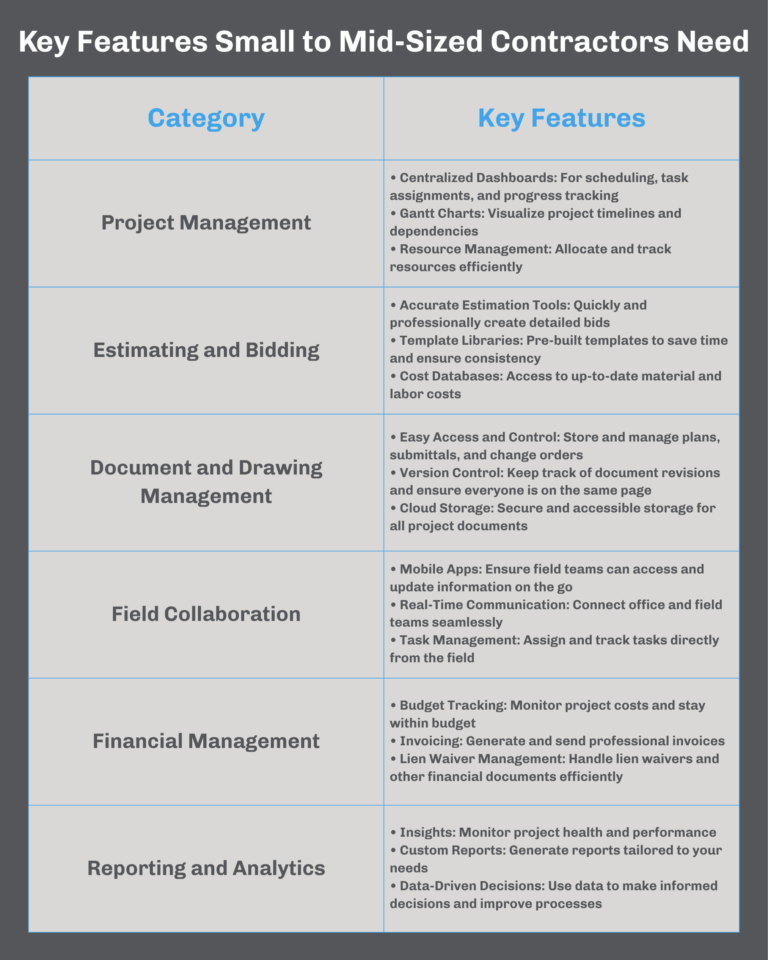
Which Construction Solution Has the Best Value for Small to Mid-Sized Contractors?
Choosing the right construction management software can make or break a small to mid-sized contractor’s success. With a plethora of options available, it’s crucial to find a solution that offers the best value—not just in terms of cost, but also in functionality, ease of use, and support tailored to your business size and needs.
In this blog, we’ll break down what small to mid-sized contractors should look for in construction management software, highlight key features to consider, and compare top platforms to help you make an informed decision.
What does “best value” mean for small to mid-sized contractors?
When evaluating construction management software, “value” isn’t just about the sticker price. It’s a combination of several factors:
Affordability
A pricing structure that fits your budget without hidden fees. Look for platforms that offer transparent pricing and flexible payment plans to accommodate your financial constraints.
Usability
Intuitive design that doesn’t require a steep learning curve. The software should be user-friendly, with minimal training needed to get your team up and running.
Functionality
Essential features that streamline your day-to-day work, such as project management, estimating, scheduling and communication. The solution should cover all the bases to ensure smooth operations.
Scalability
The ability to grow with your business, supporting more projects and users as you expand. Ensure the software can handle increased workloads without compromising performance.
Customer Support
Responsive and knowledgeable help when you need it. Reliable customer support can make a significant difference, especially when you encounter issues or need guidance.
Industry Fit
Tools tailored to the unique workflows and compliance requirements of construction. The software should be designed with the construction industry in mind, addressing specific challenges and regulatory needs.

Comparing popular platforms for small to mid-sized contractors
1. RedTeam
Why it’s valuable:
RedTeam is designed specifically with small to mid-sized contractors in mind. Its all-in-one platform combines estimating, construction project management, and financial tools with an intuitive interface and strong customer support. RedTeam also offers flexibility in deployment and pricing to fit your budget, making it a solid choice for growing companies.
Strengths:
- User-friendly with minimal training required: Easy to navigate and use, reducing the learning curve.
- Strong emphasis on collaboration between office and field: Facilitates seamless communication and task management.
- Comprehensive estimating tools integrated with project management: Streamlines the entire project lifecycle.
- Good scalability as your business grows: Supports expansion without the need for a complete system overhaul.
Ideal for:
Contractors who want a construction-specific platform with strong financial management and collaboration tools all in one place.
2. Procore
Why it’s valuable:
Procore is one of the most widely used construction platforms, offering robust features and extensive integrations. While it excels on larger projects and enterprise-level companies, smaller contractors may find its pricing and complexity challenging.
Strengths:
- Extensive features covering all aspects of construction: From pre-construction to project closeout.
- High customizability and integration options: Connect with other tools and systems you use.
- Strong document control and compliance tracking: Ensure all documents are managed and compliant with industry standards.
Ideal for:
Mid-sized contractors with larger project volumes and dedicated IT resources.
3. Buildertrend
Why it’s valuable:
Buildertrend focuses heavily on ease of use and mobile access, making it popular with small contractors and remodelers. It combines scheduling, customer management, and financial tools but may lack some depth in advanced project management features.
Strengths:
- Intuitive user interface: Simple and straightforward, ideal for teams with varying levels of tech proficiency.
- Strong customer relationship management (CRM) tools: Enhance communication and satisfaction with clients.
- Good mobile apps for field use: Keep field teams connected and productive.
Ideal for:
Smaller contractors and remodelers looking for a straightforward platform with good customer communication tools.
4. CoConstruct
Why it’s valuable:
CoConstruct is known for its robust project management and client communication features, making it a favorite among custom home builders and remodelers. It offers a user-friendly interface and a strong focus on client collaboration.
Strengths:
- Client Collaboration: Extensive tools for involving clients in the project process.
- Detailed Project Management: Comprehensive features for tracking and managing projects.
- Customizable Workflows: Tailor the platform to your specific business processes.
Ideal for:
Custom home builders and remodelers who prioritize client communication and detailed project management.
5. PlanGrid
Why it’s valuable:
PlanGrid, now part of Autodesk, is a powerful tool for document and drawing management. It’s particularly useful for field teams who need real-time access to project plans and blueprints.
Strengths:
- Document and Drawing Management: Centralized storage and version control for all project documents.
- Mobile Accessibility: High-quality mobile apps for field use.
- Integration with Autodesk: Seamless integration with other Autodesk tools for a comprehensive solution.
Ideal for:
Contractors who need advanced document and drawing management capabilities.
Making the right choice for your business
The “best value” construction management software solution for your company ultimately depends on your specific needs, project types, and growth plans. Here are some tips to help you decide:
Define your priorities
- Estimating: Do you need better estimating tools to create more accurate bids?
- Financial controls: Are tighter financial controls and budget tracking essential?
- Field collaboration: Is improved communication between office and field teams a top priority?
Consider your budget
- Software costs: Evaluate the total cost, including any additional fees for features or users.
- Onboarding and training: Factor in the time and resources needed to get your team up to speed.
Try Before You Buy
- Demos and free trials: Most platforms offer demos or free trials—take advantage of these to test real-world workflows.
- User feedback: Pay attention to user reviews and feedback to understand the platform’s strengths and weaknesses.
Ask Peers
- Network insights: Other contractors in your network can provide invaluable insights based on their experience.
- Case studies: Look for case studies and success stories from companies similar to yours.
Why Many Small to Mid-Sized Contractors Choose RedTeam
RedTeam stands out because it balances powerful construction-specific tools with ease of use and affordable pricing tailored to smaller operations. It helps contractors avoid juggling multiple disconnected apps, reducing errors and increasing efficiency.
With RedTeam, you get:
- Seamless Integration: Estimating, project management, and financials all in one solution.
- Cloud-Based Access: Office and field teams can access and update information from anywhere.
- Responsive Support: Customer support that understands your business size and challenges.
- Scalability: The solution grows with your business, supporting more projects and users as needed.
Final Thoughts
Finding the best construction management software isn’t just about the software—it’s about partnering with a solution that helps your business run smarter and grow stronger. For many small to mid-sized contractors, RedTeam delivers a winning combination of value, functionality, and support.
Ready to see how RedTeam can transform your construction business? Request a demo.



